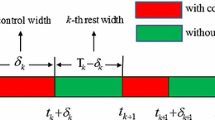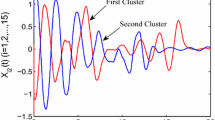Abstract
In this paper, the problem of synchronization control for directed networks with node balance is investigated. First, a dynamical model of directed network is proposed. Additionally, a new adaptive intermittent scheme is introduced to realize pinning synchronization and some novel criteria are derived by constructing a piecewise auxiliary function and utilizing piecewise analysis method and the theory of series. Based on those criteria, a feasible bound of the rate of control time is given. Finally, some examples with numerical simulations are given to demonstrate the effectiveness of the results derived.











Similar content being viewed by others
References
Strogatz, S.H.: Exploring complex networks. Nature 410, 268–276 (2001)
Albert, R., BarabIasi, A.L.: Statistical mechanics of complex networks. Rev. Mod. Phys. 74, 47–91 (2002)
Wang, P., Lü, J., Ogorzalek, M.J.: Global relative parameter sensitivities of the feed-forward loops in genetic networks. Neurocomputing 78, 155–165 (2012)
Mirollo, R.E., Strogatz, S.H.: Synchronization of pulse-coupled biological oscillators. SIAM J. Appl. Math. 50, 1645–1662 (1990)
Xie, Q., Chen, G., Bollt, E.M.: Hybrid chaos synchronization and its application in information processing. Math. Comput. Model. 35, 145–163 (2002)
Wei, G.W., Jia, Y.Q.: Synchronization-based image edge detection. Europhys. Lett. 59, 814–819 (2002)
Zhang, Q., Lu, J., Lü, J., Tse, C.K.: Adaptive feedback synchronization of a general complex dynamical network with delayed nodes. IEEE Trans. Circuits Syst. II 55, 183–187 (2008)
Zhou, J., Lu, J., Lü, J.: Adaptive synchronization of an uncertain complex dynamical network. IEEE Trans. Autom. Control 51, 652–656 (2006)
Xu, Y., Yang, H., Tong, D., Wang, Y.: Adaptive exponential synchronization in pth moment for stochastic time varying multi-delayed complex networks. Nonlinear Dyn. 73, 1423–1431 (2013)
DeLellis, P., diBernardo, M., Garofalo, F.: Novel decentralized adaptive strategies for the synchronization of complex networks. Automatica 45, 1312–1318 (2009)
Zhou, J., Wu, Q., Xiang, L., Cai, S., Liu, Z.: Impulsive synchronization seeking in general complex delayed dynamical networks. Nonlinear Anal. Hybrid Syst. 5, 513–524 (2011)
Guan, Z., Liu, Z., Feng, G., Wang, Y.: Synchronization of complex dynamical networks with time-varying delays via impulsive distributed control. IEEE Trans. Circuits Syst. I 57, 2182–2195 (2010)
Sun, W., Chen, Z., Lü, J., Chen, S.: Outer synchronization of complex networks with delay via impulse. Nonlinear Dyn. 69, 1751–1764 (2012)
Zhang, G., Liu, Z., Ma, Z.: Synchronization of complex dynamical networks via impulsive control. CHAOS 17, 043126 (2007)
Song, Q., Cao, J.: On pinning synchronization of directed and undirected complex dynamical networks. IEEE Trans. Circuits Syst. I 57, 672–680 (2010)
DeLellis, P., diBernardo, M., Porfiri, M.: Pinning control of complex networks via edge snapping. CHAOS 21, 033119 (2011)
Deng, L., Wu, Z., Wu, Q.: Pinning synchronization of complex network with non-derivative and derivative coupling. Nonlinear Dyn. 73, 775–782 (2013)
Yu, W., Chen, G., Lü, J.: On pinning synchronization of complex dynamical networks. Automatica 45, 429–435 (2009)
Chen, T., Liu, X., Lu, W.: Pinning complex networks by a single controller. IEEE Trans Circuits Syst. I 54, 1317–1326 (2007)
Wu, W., Zhou, W., Chen, T.: Cluster synchronization of linearly coupled complex networks under pinning control. IEEE Trans. Circuits Syst. I 56, 829–839 (2009)
Li, X., Wang, X., Chen, G.: Pinning a complex dynamical network to its equilibrium. IEEE Trans. Circuits Syst. I 51, 2074–2087 (2004)
Porfiri, M., Bernardo, M.: Criteria for global pinning-controllability of complex networks. Automatica 44, 3100–3106 (2008)
Zochowski, M.: Intermittent dynamical control. Phys. D 145, 181–190 (2000)
Hu, C., Yu, J., Jiang, H., Teng, Z.: Exponential stabilization and synchronization of neural networks with time-varying delays via periodically intermittent control. Nonlinearity 23, 2369–2391 (2010)
Hu, C., Yu, J., Jiang, H., Teng, Z.: Exponential lag synchronization for neural networks with mixed delays via periodically intermittent control. Chaos 20, 023108 (2010)
Li, C.D., Feng, G., Liao, X.F.: Stabilization of nonlinear systems via periodically intermittent control. IEEE Trans. Circuits Syst. II 54, 1019–1023 (2007)
Li, C.D., Liao, X.F., Huang, T.W.: Exponential stabilization of chaotic systems with delay by periodically intermittent control. Chaos 17, 013103 (2007)
Huang, T., Li, C., Yu, W., Chen, G.: Synchronization of delayed chaotic systems with parameter mismatches by using intermittent linear state feedback. Nonlinearity 22, 569–584 (2009)
Yang, X., Cao, J.: Stochastic synchronization of coupled neural networks with intermittent control. Phys. Lett. A 373, 3259–3272 (2009)
Cai, S., Liu, Z., Xua, F., Shen, J.: Periodically intermittent controlling complex dynamical networks with time-varying delays to a desired orbit. Phys. Lett. A 373, 3846–3854 (2009)
Xia, W.G., Cao, J.D.: Pinning synchronization of delayed dynamical networks via periodically intermittent control. CHAOS 19, 013120 (2009)
Cai, S., He, Q., Hao, J., Liu, Z.: Exponential synchronization of complex networks with nonidentical time-delayed dynamical nodes. Phys. Lett. A 374, 2539–2550 (2010)
Cai, S., Hao, J., He, Q., Liu, Z.: Exponential synchronization of complex delayed dynamical networks via pinning periodically intermittent control. Phys. Lett. A 375, 1965–1971 (2011)
Liu, X., Chen, T.: Cluster synchronization in directed networks via intermittent pinning control. IEEE Trans. Neural Netw. 22, 1009–1020 (2011)
Lu, W., Liu, B., Chen, T.: Cluster synchronization in networks of coupled nonidentical dynamical systems. CHAOS 20, 013120 (2010)
Lu, W., Chen, T.: Synchronisation in complex networks of coupled systems with directed topologies. Int. J. S. Sci. 40, 909–921 (2009)
Yang, M., Liu, Y., You, Z., Sheng, P.: Global synchronization for directed complex networks. Nonlinear Anal. Real World Appl. 11, 2127–2135 (2010)
Belykh, I., Belykh, V., Hasler, M.: Synchronization in asymmetrically coupled networks with node balance. CHAOS 16, 015102 (2006)
Wu, C.: Synchronization in complex networks of nonlinear dynamical systems. World Scientific Publishing, Singapore (2007)
Horn, R.A., Johnson, C.R.: Matrix Anal. Cambridge University Press, New York (2005)
Lü, J., Chen, G.: A time-varying complex dynamical network model and its controlled synchronization criteria. IEEE Trans. Autom. Control 50, 841–846 (2005)
Cai, K., Ishii, H.: Average consensus on arbitrary strongly connected digraphs with time-varying topologies. IEEE Trans. Autom. Control 59, 1066–1071 (2014)
Guo, X., Li, J.: A new synchronization algorithm for delayed complex dynamical networks via adaptive control approach. Commun. Nonlinear Sci. Numer. Simulat. 17, 4395–4403 (2012)
Cai, S., Zhou, P., Liu, Z.: Synchronization analysis of directed complex networks with time-delayed dynamical nodes and impulsive effects. Nonlinear Dyn. (2014). doi:10.1007/s11071-014-1238-z
Chen, C., Wen, G., Liu, Y., Wang, F.: Adaptive consensus control for a class of nonlinear multi-agent time-delay systems using neural networks. IEEE Trans. Neural Netw. Learn. Syst. 25, 1217–1226 (2014)
Wang, H.: Consensus of networked mechanical systems with communication delays: a unified framework. IEEE Trans. Autom. Control 50, 1571–1576 (2014)
Hadjicostis, C., Charalambous, T.: Average consensus in the presence of delays in directed graph topologies. IEEE Trans. Autom. Control 59, 763–768 (2014)
Acknowledgments
This work was supported by National Natural Science Foundation of Peoples Republic of China (Grants Nos. 61164004, 61473244, 11402223), Natural Science Foundation of Xinjiang University (Grant No. BS120101), Project funded by China Postdoctoral Science Foundation (Grant No. 2013M540782 and No. 2014T70953), Natural Science Foundation of Xinjiang (Grant No. 2013211B06), Specialized Research Fund for the Doctoral Program of Higher Education (Grant No. 20136501120001).
Author information
Authors and Affiliations
Corresponding author
Appendices
Appendix 1
1.1 Proof of Theorem 1
Proof
Construct a piecewise function described by
for \(k\in Z^+\), in which \(d_i\) is a positive constant to be determined later. It follows from (10) that \(W(t)\) is continuous except for \(t=(k+1)\hat{T}\) with \(k\in Z^+\) and
where \(\alpha =\mu \delta -2\beta (1-\delta )\) and \(\alpha >0\) from condition (2) in Theorem 1, \(W_+((k+1)\hat{T})\) and \(W_-((k+1)\hat{T})\) denote the right limit and the left limit of \(W(t)\) at time \((k+1)\hat{T}\), respectively.
Introduce the following Lyapunov function
where
Evidently, \(U(t)\) is continuous for all \(t\ge 0\), and \(V(t)\) is continuous except for \(t=(k+1)\hat{T}\) with \(k\in Z^+\) and it is right continuous at \(t=(k+1)\hat{T}\).
For \(k\hat{T}\le t\le (k+\delta )\hat{T}\), the upper right derivative of \(V(t)\) with respect to time \(t\) along the error system (12) can be calculated as follows:
where \({\tilde{\mathbf {e}}^\mathbf{k}}=(e_1^k,e_2^k,\ldots ,e_N^k)^T\) for \(k=1,2,\ldots ,n\),
Obviously, \(\mathbf {G}\) is a real symmetric matrix, by Lemma 1, \(\mathbf {G}-{\hat{\mathbf {D}}}<0\) is equivalent to
when \(d_i\) (\(i=1,2,\ldots ,l\)) are sufficiently large.
In addition, according to Lemma 2 and condition (13),
which implies that \(\mathbf {G}_l<0\) and then \(\mathbf {G}-{\hat{\mathbf {D}}}<0\), this together with (26), we have
for \(k\hat{T}\le t\le (k+\delta )\hat{T}\).
Similarly, for \((k+\delta )\hat{T}<t<(k+1)\hat{T}\),
Since the graph of (3) is strongly connected, then it follows from Ref. [40] that the coupling matrix \(\mathbf {A}=(a_{ij})_{N\times N}\) and \(\mathbf {A}^T\) are irreducible. According to Lemma 3, the eigenvalues of \(\frac{\mathbf {A}+\mathbf {A}^T}{2}\) can be denoted by \(0=\hat{\lambda }_1>\hat{\lambda }_2\ge \hat{ \lambda }_3\ge \ldots \ge \hat{ \lambda }_N\). Besides, it is easy to see that \(\frac{\mathbf {A}^T+\mathbf {A}}{2}\) is a real symmetric matrix, then there exists a unitary matrix \(\mathbf {P}=(P_1,\ldots , P_N)\) satisfying \(\mathbf {P}^T\mathbf {P}={\mathbf {I}}_{\mathbf{N}}\) such that
where \(\mathbf {Q}=\text{ diag }(\hat{\lambda }_1, \hat{\lambda }_2,\ldots ,\hat{\lambda }_N)\). Therefore,
where \({\mathbf {P}}\tilde{\mathbf{e}}^\mathbf{k}(t)={\mathbf {y}}^\mathbf{k}(t)=\left( y_1^k(t),\ldots ,y_N^k(t)\right) ^T\) for \(k=1,2,\ldots ,n\).
Hence, for \((k+\delta )\hat{T}< t<(k+1)\hat{T}\),
In the following, we will prove that
By virtue of (24), (28) and (29), we can derive that
which implies that
and then
it shows that
therefore, by the theory of series,
In addition, for \(k\hat{T}\le t< (k+1)\hat{T}\), in view of the nonnegativity of \(d_i(t)\), it is easy to estimate that
where \(\hat{\lambda }=\max \,\{\hat{\lambda }_i,\ i=1,2,\ldots ,n\}\), \(\hat{\lambda }_i\) is the largest eigenvalue of the matrix \(\theta {\mathbf {I}}_{\mathbf{N}}+c\gamma _i\frac{\mathbf {A}^T+\mathbf {A}}{2}\). In view of this, we have
Evidently, \(k\rightarrow \infty \) when \(t\rightarrow \infty \), this combines with (32) and (33), we obtain
Therefore, the asymptotical synchronization of the controlled network (6) is realized, and the proof of Theorem 1 is completed.\(\square \)
Appendix 2
1.1 Proof of Corollary 1
Proof
From inequality (14),
Denote \(\mu =-2(\theta +c\gamma \lambda _{l+1})\) and \(\beta =\theta \), then condition (13) holds and
It follows from Theorem 1 that the network (6) is globally asymptotically synchronized.\(\square \)
Rights and permissions
About this article
Cite this article
Hu, C., Jiang, H. Pinning synchronization for directed networks with node balance via adaptive intermittent control. Nonlinear Dyn 80, 295–307 (2015). https://doi.org/10.1007/s11071-014-1869-0
Received:
Accepted:
Published:
Issue Date:
DOI: https://doi.org/10.1007/s11071-014-1869-0




